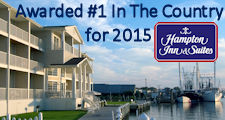Chincoteague Pony Frequently Asked Questions |
All Articles |
|
Where did the Chincoteague Ponies come from? It is estimated that the Ponies have lived on Assateague for over 400 years. While no one knows for sure exactly how they originally got there, there are two main theories. Theory #1: Brought by early settlers... This theory contends that the Ponies living on Assateague Island today are descendants of domesticated horses turned loose to graze by early settlers. Early settlers to the area were farmers on the mainland and no one lived on the barrier Islands of Chincoteague and Assateague. Mainland communities instituted ‘fencing laws’ to keep free-roaming livestock out of towns or from causing crop damage. In addition farmers were required to pay taxes on their herds of livestock. In an effort to avoid building expensive fences, and to avoid paying the livestock taxes, farmers moved their livestock (including horses, cows, sheep, and pigs) to nearby barrier Islands. The barrier Islands provided a natural corral made of water. Theory #2: Shipwreck survivors... If you’ve ever seen a shipwreck map of the mid Atlantic coastline, then you know that there were a remarkable number of shipwrecks in the 16th and 17th centuries. Before modern navigation, ships used lighthouses and the stars to navigate at night. This worked well until a bad storm came up or heavy fog set in, which impaired visibility. Unable to see the lighthouse ships would get off course and hit sandbars along the coast. This would usually occur during a storm and the large waves would beat the wooden ship apart. The large number of shipwrecks, together with the fact that it was very common for ships to be transporting ponies to the Colonies or South America, makes it very likely that ponies originally got to Assateague from a shipwreck. It is also possible that both theories are correct. What type of horse is the Chincoteague Pony? The Chincoteague Pony became its own official registered breed in 1994. The average height of a Chincoteague Pony is between 12 and 13 hands (any horse that stands less than 14 hands is considered a Pony). Chincoteague Ponies are stocky, with short legs, thick manes, and large, round bellies. Though they are named after Chincoteague (the closest populated town) they actually live on Assateague Island, which is an undeveloped National Wildlife Refuge. What do the Chincoteague Ponies eat? Assateague Island is a harsh environment for the Ponies and their diet is limited. The Ponies have adapted to the limited diet over the hundreds of years they have lived on Assateague. The Ponies primarily eat the salt water cord grass that grows in the marshes on Assateague Island. They eat almost all day just to get enough nutrition from this diet to sustain themselves. The salt content of the cord grass is very high. To compensate for all the salt in the cord grass they drink twice as much water as a normal horse. This is why their bellies appear so bloated. Where do the Chincoteague Ponies find fresh water? The Chincoteague Ponies find fresh, or brackish, water in low lying areas of Assateague Island that collect rain water. They also drink from Vernal Pools (link to Wikipedia) found on Assateague Island. Needles from nearby Loblolly Pine Trees collect in the Vernal Pools. The acidity of the pine needles prevents the water in the Vernal Pools from spoiling. Is the Chincoteague Pony population controlled? On average around 60 to 70 new foals are born every spring in the herd on the Virginia side of Assateague Island. Approximately 75 percent of the mature mares have foals each year, a relatively high foaling rate for wild horses. A mare can become pregnant again once her foal has stopped nursing. And with an 11 month gestational cycle many of the mares are pregnant almost year around! The Chincoteague Volunteer Fire Company, who owns and manages the Virginia herd, maintains the herd size at about 150 adult ponies. The Fire Company controls the size of the herd by auctioning off most of the foals at the annual Pony Auction in July. Each year just a few select foals are designated as 'buybacks'. A buyback pony is auctioned with the stipulation that it will be donated back to the Fire Company and returned to Assateague Island to replenish the herd. The winner of a buyback pony gets to name the pony before it is returned to Assateague Island to live out its life there. Buyback ponies have actually become some of the highest priced foals sold at the auction. There is another herd of Ponies on the Maryland side of Assateague Island, separated by a fence across the Island at the Maryland-Virginia state line. The National Park Services uses a contraceptive vaccine to control overpopulation. The vaccine is delivered by a dart to the hindquarters of selected mares each spring to prevent pregnancy. Do the Chincoteague Ponies receive any assistance from humans? CVFC uses some of the money they make at their annual pony auction and carnival to provide veterinary care to the ponies on the Virginia side of Assateague Island. 3 times of year, spring, summer, and fall. Vaccines and hoof care. Additionally the CVFC provides hay to the ponies during harsh winter conditions of snow and ice. On the Maryland side of Assateague Island action may be taken to end the suffering of a gravely ill, seriously injured, or dying pony. Otherwise the National Park Service treats the Maryland ponies the same as other species of Assateague wildlife. Where is the best place to see the Chincoteague Ponies in the wild? About fifty of the adult ponies are fenced into an area just to the south of the main road and can be viewed by the public. The south herd is best seen from the Beach Road, from the observation decks at the Woodland and Pony Trails, and by scenic boat tour. The other hundred adult ponies are kept in an area further north which is only accessible by scenic tour boat or wildlife bus tour. What is the Chincoteague Ponies social structure? The wild ponies on Assateague Island congregate in small groups, called "bands". Each band has one dominate stallion and the rest are mares that the stallion breeds with. The number of mares a particular stallion has in his band is dependent upon how dominate the stallion is. The stronger the stallion the more mares he is able to win when fighting other stallions on the Island. The dominate stallion will kick his male offspring out of the band after a couple of years, once the colt has reached sexual maturity. Young bachelor males tend to form their own small band, until they become big and strong enough to begin fighting for and winning mares from other stallions. Likewise, female offspring are eventually chased off by their mother to prevent inbreeding. What is life like for a wild Chincoteague Pony? Assateague Island is a harsh habitat for the Chincoteague Ponies and they have adapted to life there over hundreds of years. Spring brings cool, rainy weather and fresh plant growth to the Island. The ponies tend to stay near the marshes, close to their best food sources. Summer brings heat, humidity, and insects. The ponies tend to congregate near the water at the perimeter of the Island to catch a breeze and escape mosquitoes and flies. Cooler fall weather allows the ponies to move from water’s edge back to the marshes and their abundant grasses. The ponies prefer to browse in shrub thickets during the damp, chilly, winter season. They grow thick furry coats that protect them from the ferocious winter winds and occasional snow storms. Who was Misty of Chincoteague? Misty was born on July 20, 1946 at the Beebe Ranch on Chincoteague Island, owned by Clarence and Ida Beebe. Marguerite Henry wanted to buy Misty to take back with her to be the model for her book. Clarence Beebe at first refused, but sold her after Mrs. Henry promised to include his grandchildren Maureen and Paul Beebe in the book. Misty stayed with Mrs. Henry for over ten years, appearing for her fans at schools, movie theaters, museums, libraries, and horse shows. Misty was sent back to the Beebe Ranch in 1957 to have her foals. Clarence Beebe died soon after Misty's return and Ida Beebe asked their son Ralph to take care of Misty. Misty died in her sleep on October 16, 1972 at age 26. Click here to learn more about Misty of Chincoteague. |
HOME | ACCOMMODATIONS | DINING | ACTIVITIES | REAL ESTATE | SHOPS | SERVICES | EVENTS | PONIES | PONY SWIM GUIDE | PONY SWIM PICS
PONY ROUNDUP PICS | PONIES BY NAME | WEB CAM | SPECIALS AND DISCOUNTS | INTERACTIVE CHINCOTEAGUE MAP | LOCATION | PHOTOS | NEWS
Chincoteague.com
4099 Bradley Lane
Chincoteague Island, VA 23336

Advertise With Us!



